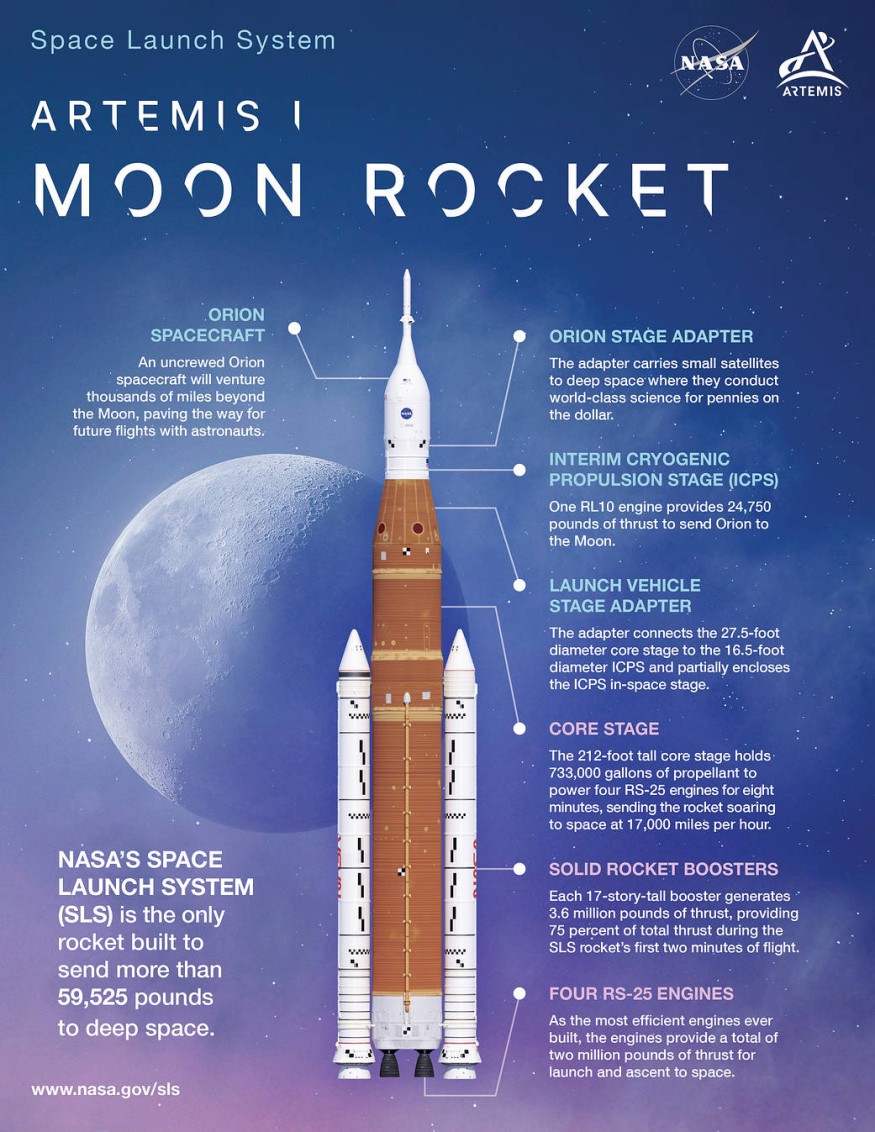The Space Launch System (SLS) rocket performed well in its debut launch on Artemis I. Earth's most powerful rocket is now set NASA's Orion spacecraft on course for an expedition beyond the Moon and back, employing the foundation for the prior mission with astronauts and astronomers on Artemis II and humanity's return to the lunar surface with Artemis III.
The solid rocket booster motors responsible for providing over 7 million pounds of thrust at takeoff performed as expected, allowing the rocket and spacecraft to travel over 27 miles from the Kennedy Space Center in Florida and reach a speed of around 4,000 mph in just over two minutes before separating. No problems were reported with the booster subsystems, including their avionics and thrust vector control system used for steering.
Mike Sarafin, Artemis mission manager, described the first launch of the Space Launch System rocket as "eye-watering". He said that, although the mission with Orion is still in progress and they are still learning, the rocket's systems performed exactly as expected in every aspect.

Exceeding Expectations
The NASA analysis of the rocket's core stage and four RS-25 engines, which burned through the stage's 735,000 gallons of propellant in just over eight minutes, showed that they met all expectations during launch and in the final minutes before liftoff when the flight computers and software were in control and many dynamic events occurred quickly in succession.
As stated by the space agency, the Moon rocket delivered Orion to within about three miles of its planned orbit altitude of 975 by 16 nautical miles, well within the range required for the mission, at a speed of around 17,500 mph. The analysis also showed that the rocket's ascent and in-space software performed as expected.
The interim cryogenic propulsion stage, the upper stage of the rocket used for the mission, performed as planned. The upper stage's single RL10 engine, which has been used on successful missions to every planet in the solar system and interstellar space over its more than 50 years of operation, set a single-duration burn record by firing for over 18 minutes to set Orion on its multi-day journey to the Moon.

ALSO READ: Side-by-Side Comparison of NASA's SLS and Saturn V: Cost, Height, Weight, Speed, Thrust, and Payload
Monitoring SLS Performance
According to Sarafin, performance was off by less than 0.3 percent in all cases. Engineers will continue to conduct a more detailed analysis of the Space Launch System's performance over the next few months as the agency continues to build and assemble elements for the rocket for the Artemis II mission and beyond.
John Honeycutt, SLS program manager at NASA's Marshall Space Flight Center in Huntsville, Alabama, said that he has been privileged to lead the team that designed, built, tested, and now dashed the Space Launch System rocket on its historical first-ever flight, the Artemis I.
With the amazing Moon rocket, the team he leads has laid the foundation for Artemis and its long-term presence on the Moon. The performance of the rocket and the team supporting its maiden voyage was outstanding, Honeycutt added.
The SLS Program is managed by Marshall, and many parts of the rocket were built and tested at Marshall, NASA's Michoud Assembly Facility in New Orleans, and Stennis Space Center in Bay St. Louis, Mississippi. Engineers at Marshall supported the Artemis I launch in real-time from the center's SLS Engineering Support Center and the Launch Control Center at NASA's Kennedy Space Center in Florida.
New RS-25 Engine Trials for Upcoming Artemis Expeditions
On December 14, NASA will begin a new series of hot fire tests at Stennis Space Center near Bay St. Louis, Mississippi, to support the production of future RS-25 engines for the Space Launch System (SLS) rocket. The hot fire test, which is expected to last for 500 seconds, will be live-streamed on the NASA Stennis Space Center Facebook and YouTube pages before ignition. The test window is scheduled to open at 2:00 PM CST. The initial single-engine hot fire, known as a confidence test, is designed to confirm that everything is ready to proceed with a series of certification tests on a full RS-25 certification engine early next year.
The test will provide initial data to NASA and lead SLS engine contractor Aerojet Rocketdyne as they prepare to begin production of new RS-25 engines for future Artemis missions to the Moon and eventual journeys to Mars. For each SLS flight, four RS-25 engines, along with two solid rocket boosters and a core stage, help power the rocket at liftoff. NASA and Aerojet Rocketdyne modified 16 of the remaining engines from the Space Shuttle Program for use on Artemis missions I through IV. The upcoming series of tests will be for the RS-25 engines that will be used starting with Artemis V.
The confidence hot fire test is expected to last approximately eight and a half minutes (500 seconds), the length of time that the engines must fire during an actual flight. The engine will operate at up to 111% of its power level, the same level needed to power SLS, for most of the test. It will briefly throttle down to 80% before boosting back up to 111%, and then slowing down again to conclude the testing.
RELATED ARTICLE: NASA Says Tanking Test of Artemis 1's SLS Megarocket Is "Successful"
Check out more news and information on Space in Science Times.
© 2025 ScienceTimes.com All rights reserved. Do not reproduce without permission. The window to the world of Science Times.











